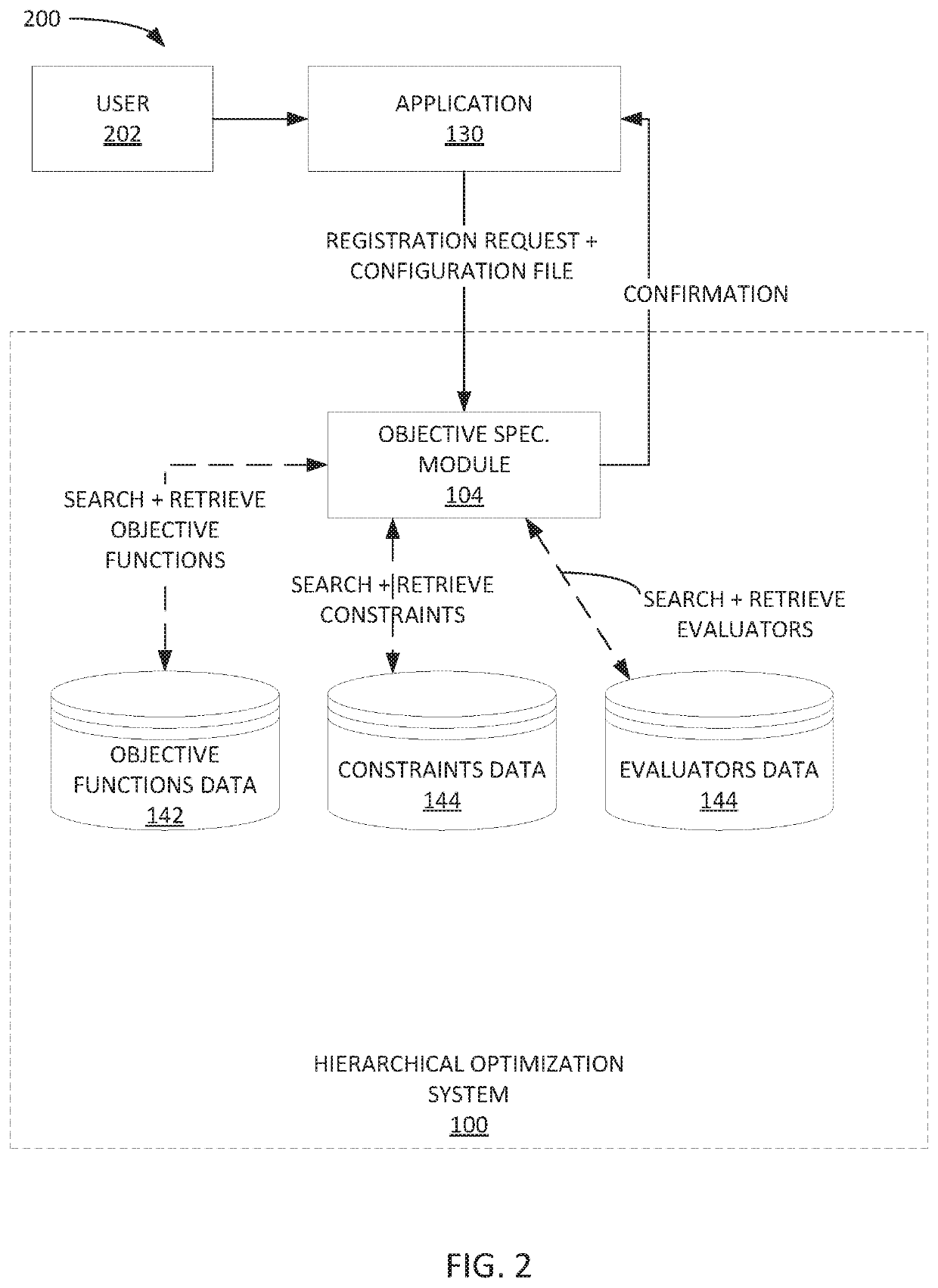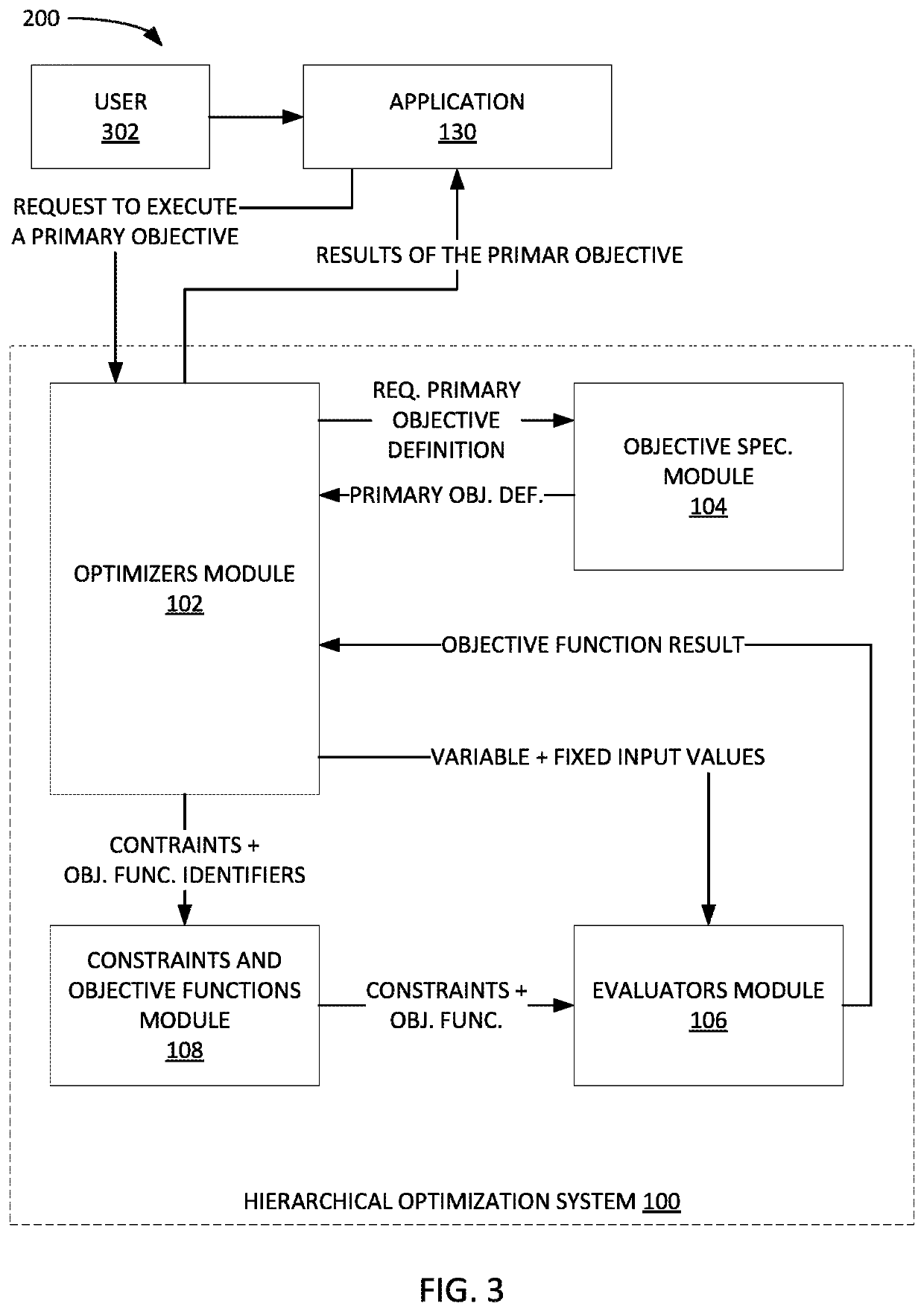Hierarchical optimization for processing objectives sequentially and/or iteratively
a technology of processing objectives and optimization, applied in the field of hierarchy optimization for processing objectives, can solve problems such as non-linear computation, complex and regulated objectives, and constraints on values
- Summary
- Abstract
- Description
- Claims
- Application Information
AI Technical Summary
Benefits of technology
Problems solved by technology
Method used
Image
Examples
example hierarchical
[0029]FIG. 1 depicts an example hierarchical optimization system 100 for optimizing one or more primary objectives. As shown in FIG. 1, the hierarchical optimization system 100 may be communicatively coupled to an application 130, and a data store 140. The hierarchical optimization system 100 includes optimizers module 102, objective specifications module 104, evaluators module 106, constraints and objective functions module 108.
[0030]The optimizers module 102 may include one or more optimizers 112a, 112b, . . . , 112n, collectively referred to as optimizers 112, which are configured to determine the optimal values for the variable inputs of a sub-objective. Examples of the one or more optimizers 112 may include, but are not limited to, simplicial homology global optimisation (SHGO) optimizers, sequential least squares quadratic programming (SLSQP) optimizers, linear programming (LinProg) optimizers, and the like. In some implementations, each optimizer 112 may be...
example method
of Hierarchical Optimization for Processing Objectives Sequentially And / Or Iteratively
[0062]FIG. 4 depicts an example method 400 of hierarchical optimization of processing objectives sequentially and / or iteratively.
[0063]Method 400 begins at step 402 with receiving a request to optimize a primary objective from a requestor.
[0064]In some implementations, the request to optimize a primary objective may include an identifier associated with the primary objective. In some implementations, the requestor may be an application (e.g., application 130) communicatively coupled to a hierarchical optimization system (e.g., the hierarchical optimization system 100).
[0065]Method 400 then proceeds to step 404 with determining, based on the request, an ordered set of stages to optimize the primary objective.
[0066]As described above, an ordered set of stages to optimize the primary objective may be provided by a user (e.g., domain expert), and the ordered set of stages is a sequence in which the sta...
example processing
[0078]FIG. 5 depicts an exemplary processing system 500 configured to perform methods for hierarchical optimization of processing objectives sequentially and / or iteratively.
[0079]Processing system 500 includes a CPU 502 connected to a data bus 508. CPU 502 is configured to process computer-executable instructions, e.g., stored in memory 510 or storage 530, and to cause processing system 500 to perform methods as described herein, for example with respect to FIGS. 2-4. CPU 502 is included to be representative of a single CPU, multiple CPUs, a single CPU having multiple processing cores, and other forms of processing architecture capable of executing computer-executable instructions.
[0080]Processing system 500 further includes input / output devices and interface 504, which allows processing system 500 to interface with input / output devices, such as, for example, keyboards, displays, mouse devices, pen input, touch sensitive input devices, cameras, microphones, and other devices t...
PUM
 Login to View More
Login to View More Abstract
Description
Claims
Application Information
 Login to View More
Login to View More - R&D
- Intellectual Property
- Life Sciences
- Materials
- Tech Scout
- Unparalleled Data Quality
- Higher Quality Content
- 60% Fewer Hallucinations
Browse by: Latest US Patents, China's latest patents, Technical Efficacy Thesaurus, Application Domain, Technology Topic, Popular Technical Reports.
© 2025 PatSnap. All rights reserved.Legal|Privacy policy|Modern Slavery Act Transparency Statement|Sitemap|About US| Contact US: help@patsnap.com



